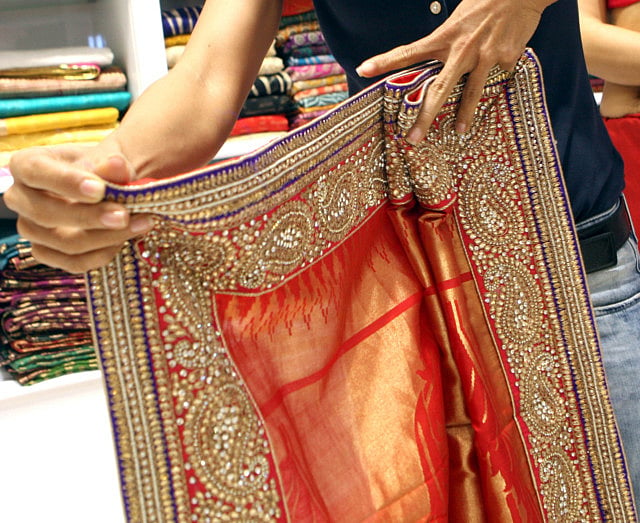The sari defines an Indian woman in the way it envelopes and make one feel feminine. Often women find it tricky to wear it but, as they say, practice makes you perfect.
“The sari symbolises nostalgia to me — a happy nostalgia,” says Uma Ghosh-Deshpande, TV personality, model and brand ambassador of Kala Niketan.
“I remember my mother looking fabulous in a sari. Most Bengali women are obsessed with saris, and I am a Bengali. I started wearing saris for festivals and to college — we used to have an event called Sari Day where all the girls draped saris, enjoyed getting dressed and helping others.
“I have seen the sari evolve greatly from just being a piece of cloth. Now we have so many different styles and fabric. We have embroidered saris, net saris, two-piece saris, we have saris with varied borders, prints — digital print is big right now — and I think we’ve lapped it all up.
“We Indian women look the best in a sari. I believe women look really sensuous in them. Our men like to see us in sari. And we are always waiting for something modern, something new.
“A sari can suit any shape and size. As brand ambassador my job is to introduce women of all nationalities to the sari. I know a lot of them and they all love to wear saris but want to learn how to wear one. I give a lot of saris during the festive season. It’s lovely to see women of different nationalities wearing them, especially during Diwali”.
Ghosh-Deshpande shows us two popular draping styles
The sari entails a blouse (the top) and a petticoat (underskirt). It is essential to remember that there are two sides of the sari: the fall or the lower part and the pallu or the loose end which hangs over the shoulder.
The Ulta-palla style
- Start by tucking in the top part of the fall side of the sari into the petticoat, twirl, such that it covers the entire petticoat
- Then, with your left hand spread out — your little and index fingers as the measurement — pleat the sari into folds. Usually four to six folds will happen, depending on your girth. Hold in one hand
- Drape the pallu side over the left shoulder, making sure it isn’t dragging on the floor or is too short. Ideal length of the pallu should be between your knee and ankle
- If there is any loose length at the waist, make more pleats. Else tuck in the top part of the pleats into the petticoat as shown. (To secure the pleats into place, use safety pins. Taking the lowest pleat, run the safety pin through the back of the pleats under the petticoat)
- For the pallu, you can either secure the top end on the shoulder with a safety pin or pleat it like the fall side and then secure with a pin
The Gujarati style
- Start by tucking in the top part of the fall side of the sari into the petticoat, twirl, such that it covers the entire petticoat
- Then, with your right hand spread out — your little and index fingers as the measurement — pleat the sari into folds. Usually four to six folds will happen, depending on your girth. Hold in one hand
- Take the pallu across the back to your right shoulder, bringing the loose end over your chest
- If there is any loose length at the waist, make more pleats. Else tuck in the top part of the pleats into the petticoat as shown. (To secure the pleats into place, use safety pins. Taking the lowest pleat, run the safety pin through the back of the pleats under the petticoat)
- Now pleat the pallu as shown, pinning it on the right shoulder. Take the loose right end of the pallu and either tuck it into the petticoat waist band at the back or pin on the left underside of the blouse
Sign up for the Daily Briefing
Get the latest news and updates straight to your inbox
Network Links
GN StoreDownload our app
© Al Nisr Publishing LLC 2025. All rights reserved.
